What is Static VAR Compensator (SVC)? Circuit & Operation in PF Correction
What is Static VAR Compensator – SVC?
A Static VAR Compensator (SVC) also known as Static Reactive Compensator is a device used to improve the power factor of an electrical power system. It is a type of static reactive power compensation device that is used to inject or absorb reactive power into or out of the system to maintain a desired voltage level.
An SVC is a part of FACTS (flexible AC transmission system) and consists of a bank of capacitors and reactors, which are controlled by power electronics such as thyristors or insulated gate bipolar transistors (IGBTs). The power electronics can rapidly switch the capacitors and reactors on and off in order to inject or absorb reactive power as needed. The control system for the SVC monitors the system voltage and current and adjusts the reactive power output of the device accordingly.
SVCs are generally used to compensate for fluctuations in reactive power caused by changes in load demand or changes in generation, such as the output from wind or solar power sources. The SVC works by injecting or absorbing reactive power into the power system in order to maintain a constant voltage and power factor at the point of connection.
Construction of SVC
A Static VAR Compensator (SVC) typically consists of several components, including a thyristor-controlled reactor (TCR), a thyristor-switched capacitor (TSC), filters, a control system, and other auxiliary components as follows.
- Thyristor-Controlled Reactor (TCR): The TCR is a reactor that is connected in parallel with the power transmission line. It is controlled by a thyristor device, which regulates the inductive reactive power.
- Thyristor-Switched Capacitor (TSC): The TSC is a capacitor that is also connected in parallel with the power transmission line. It is controlled by thyristor devices, which regulate the capacitive reactive power.
- Filters and Reactors: used to eliminate the harmonic in the power system
- Control System: The control system of the SVC is responsible for monitoring the voltage and current in the power transmission line and controlling the TCR and TSC to maintain the desired voltage level and power factor. The control system typically includes a microprocessor-based controller, which receives signals from sensors and sends signals to the thyristor devices to adjust the reactive power injection or absorption.
- Auxiliary Components: The SVC may also include other auxiliary components, such as filters, transformers, and protective devices, to ensure proper operation and protection of the system.
Working of Static VAR Compensator
An SVC (Static VAR Compensator) is an electrical device used to regulate the voltage and reactive power (VAR) in electrical power transmission and distribution systems. It is a type of static compensator that uses power electronics to control the voltage and VAR on the electrical grid.
The SVC consists of a thyristor-controlled reactor (TCR) and a thyristor-switched capacitor (TSC). The TCR and TSC are connected in parallel with the power transmission line. The TCR is used to control the inductive reactive power and the TSC is used to control the capacitive reactive power. The combination of the TCR and TSC allows the SVC to quickly and accurately inject or absorb reactive power to maintain a desired voltage level and improve the power factor of the system.
The SVC continuously monitors the voltage and current in the power transmission line and adjusts the reactive power injection or absorption based on the voltage level. If the voltage level drops below the desired level, the SVC will inject reactive power into the system. Conversely, if the voltage level rises above the desired level, the SVC will absorb reactive power from the system.
The TCR and TSC are typically connected in series with a common DC bus, which is controlled by the control system. The control system adjusts the firing angle of the thyristor devices to regulate the reactive power injection or absorption by the TCR and TSC. The combination of the TCR and TSC allows the SVC to quickly and accurately inject or absorb reactive power to maintain a desired voltage level and improve the power factor of the system.
By injecting or absorbing reactive power as needed, the SVC helps to maintain a stable voltage level and improve the power factor of the system. This helps to reduce losses in the system and improve overall system efficiency.
Advantages of VAR Compensator
The Static VAR Compensator has several advantages. An SVR:
- Enhances the power transmission capability of transmission lines
- Improves system transient stability
- Controls steady-state and temporary overvoltage
- reduced line losses and increased system capability
- has no moving parts, hence less maintenance is required
- Improves the overall load power factor
Applications of SVRs
- SVCs are commonly used in high-voltage transmission systems and large industrial plants, where fluctuations in load demand can cause voltage instability and other power quality issues. They can help to improve power system stability, increase power transfer capability, and reduce losses in the electrical grid.
- SVR is used for surge impedance compensation and to compensate for long transmission lines by sectionalizing them.
- Improve the overall power factor for smooth and stable power system.
Related Posts:
- What is Power Factor?
- Causes of Low Power Factor
- Disadvantages of Low Power Factor
- Advantages of Power Factor Improvement and Correction
- Active, Reactive, Apparent and Complex Power
- How to Calculate the Suitable Capacitor Size in µ-Farads & kVAR for P.F Improvement
- How to Convert Capacitor μ-Farads to kVAR and Vice Versa? – For P.F Correction
- μ-Farad to kVAR Calculator – How to Convert Farads to kVAR?
- kVAR to Farad Calculator – How to Convert kVAR to μ-Farads?
- Capacitor Bank in kVAR & µF Calculator for Power Factor Correction
- Capacitor Bank – Characteristics And Applications
- Power Factor Correction Calculator – How to Find P.F Capacitor in µF & kVAR?
- Introduction of Custom Power Devices For Power Quality Improvement

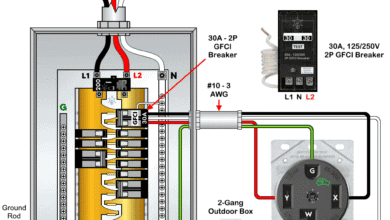 How to Wire a 30A, 125V/250V – NEMA 14-30 Receptacle
How to Wire a 30A, 125V/250V – NEMA 14-30 Receptacle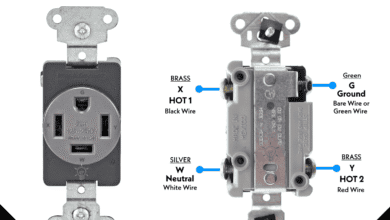 How to Wire a 20A, 125V/250V – NEMA 14-20 Receptacle
How to Wire a 20A, 125V/250V – NEMA 14-20 Receptacle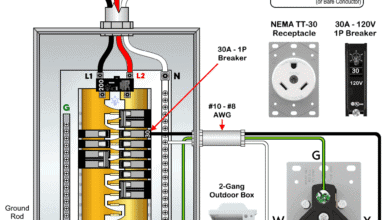 How to Wire NEMA TT-30 Receptacle for RVs & Travel Trailers
How to Wire NEMA TT-30 Receptacle for RVs & Travel Trailers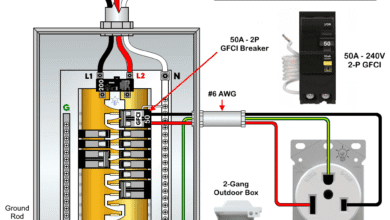 How to Wire a 50A – 250V, NEMA 6-50 Receptacle
How to Wire a 50A – 250V, NEMA 6-50 Receptacle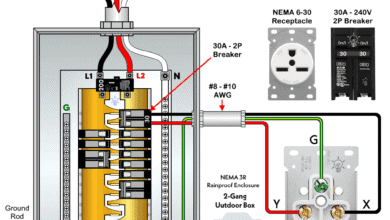 How to Wire a 30A – 250V, NEMA 6-30 Receptacle
How to Wire a 30A – 250V, NEMA 6-30 Receptacle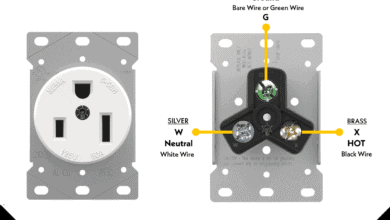 How to Wire a 50A – 125V – NEMA 5-50 Receptacle
How to Wire a 50A – 125V – NEMA 5-50 Receptacle